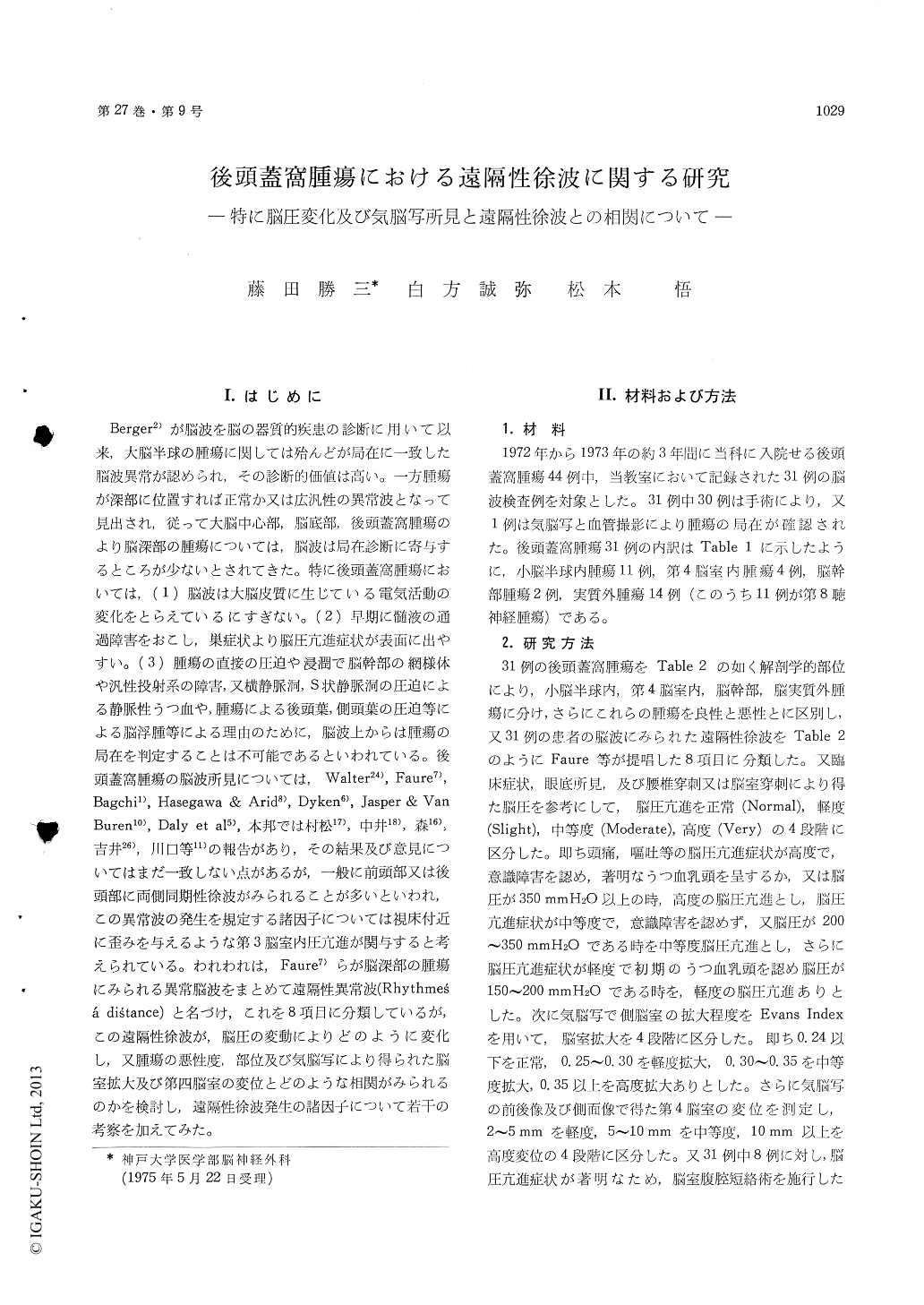Japanese
English
- 有料閲覧
- Abstract 文献概要
- 1ページ目 Look Inside
I.はじめに
Berger2)が脳波を脳の器質的疾患の診断に用いて以来,大脳半球の腫瘍に関しては殆んどが局在に一致した脳波異常が認められ,その診断的価値は高い。一方腫瘍が深部に位置すれば正常か又は広汎性の異常波となって見出され,従って大脳中心部,脳底部,後頭蓋窩腫瘍のより脳深部の腫瘍については,脳波は局在診断に寄与するところが少ないとされてきた。特に後頭蓋窩腫瘍においては,(1)脳波は大脳皮質に生じている電気活動の変化をとらえているにすぎない。(2)早期に髄液の通過障害をおこし,巣症状より脳圧亢進症状が表面に出やすい。(3)腫瘍の直接の圧迫や浸潤で脳幹部の網様体や汎性投射系の障害,又横静脈洞,S状静脈洞の圧迫による静脈性うつ血や,腫瘍による後頭葉,側頭葉の圧迫等による脳浮腫等による理由のために,脳波上からは腫瘍の局在を判定することは不可能であるといわれている。後頭蓋窩腫瘍の脳波所見については,Walter24),Faure7),Bagchi1),Hasegawa&Arid8),Dyken6),Jasper&VanBuren10),Daly et al5),本邦では村松17),中井18),森16),吉井26),川口等11)の報告があり,その結果及び意見についてはまだ一致しない点があるが,一般に前頭部又は後頭部に両側同期性徐波がみられることが多いといわれ,この異常波の発生を規定する諸因子については視床付近に歪みを与えるような第3脳室内圧亢進が関与すると考えられている。われわれは,Faure7)らが脳深部の腫瘍にみられる異常脳波をまとめて遠隔性異常波(Rhythmeśá diśtance)と名づけ,これを8項目に分類しているが,この遠隔性徐波が,脳圧の変動によりどのように変化し,又腫瘍の悪性度,部位及び気脳写により得られた脳室拡大及び第四脳室の変位とどのような相関がみられるのかを検討し,遠隔性徐波発生の諸因子について若干の考察を加えてみた。
E. E. G. was taken in 31 cases of posterior fossatumors, varified at operation or autopsy. Distantrhythm, classified by Dr. Fraue, was analysed onthe basis of clinical and neuroradiological data.
1) Abnormal E. E. G.'s were found in 24 casesof the 31 cases (77%). This abnormal E. E. G. wasmost frequently found in the cerebellar tumors andalso malignant tumors in the posterior fossa, un-related to their location and least frequently foundin the cerebello-pontine angle tumors.
2) Lateralizing signs in the E. E. G. were foundto be no reliable.
3) E. E. G.'s were taken in 8 cases with increasedintracranial pressure after and before ventriculo-peritoneal shunts. Monorhythmic or polymorphicdelta waves disappeared in most cases of benignposterior fossa tumors, but persisted in cases ofmalignant tumors after ventriculo-peritoneal shunts.
4) Degree of hydrocephalus and shift of IV thventricle obtained in air study did not correlatewith E. E. G. abnormality and distant rhythm.
5) Pressure increase in the III rd ventricle andedema of the brain stem occupy a key position asa pathogenetic mechanism for distant rhythm.

Copyright © 1975, Igaku-Shoin Ltd. All rights reserved.


